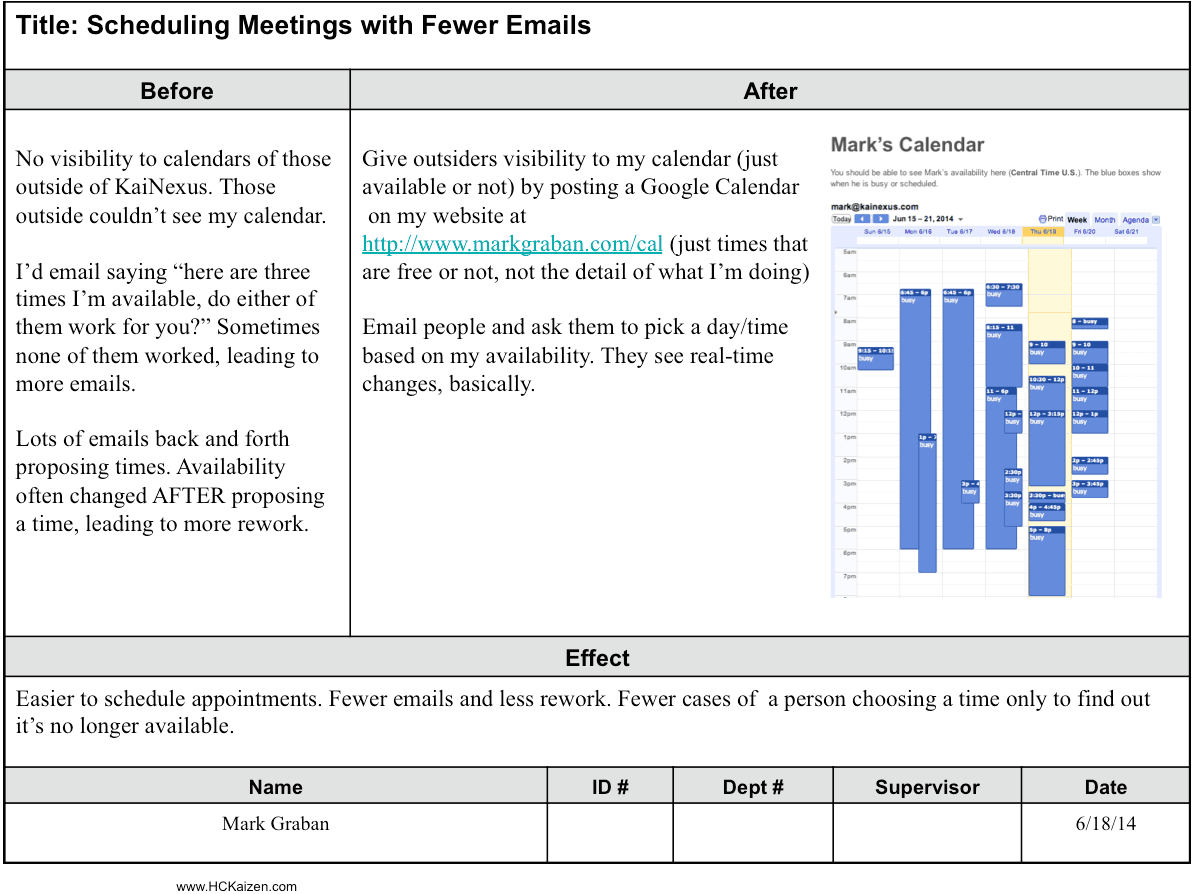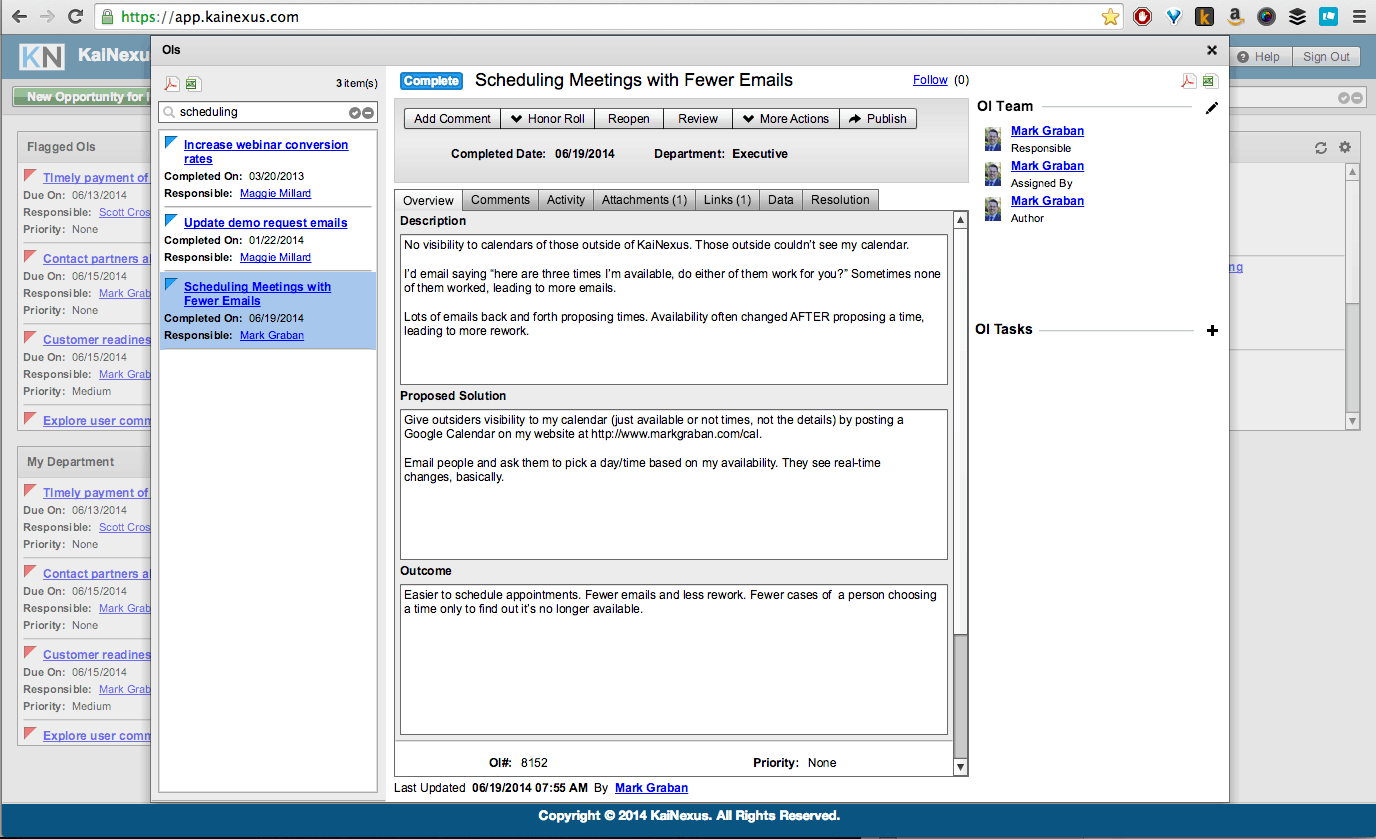One of the key aspects of the Kaizen process is that we SHARE completed improvements with others. That's a key principle that Joe Swartz and I wrote about in Healthcare Kaizen, and it's a key aspect of the KaiNexus software platform.
Another important Kaizen behavior is leading by example and I try to do that. One way I lead by example is to implement and share my own Kaizens (like this one that Joe and I did earlier this year).
Kaizen starts with identifying a problem or an opportunity for improvement. For me, a problem was having too many emails going back and forth about scheduling a meeting time. People are sometimes hard to reach by phone in order to have that discussion in real time. So, emails are used. Even with trying to propose “here are a few times that would work for me,” that process often broke down because:
- None of those times were good for the other party
- My schedule would change in the mean time due to something out of my control
So, I decided to share my calendar publicly via my personal website – it shows when I'm busy or free, but not the detail of what I'm doing.
This new process is working MUCH better. I'm spending less time on getting meeting times solidified (although I don't have a measure of the amount of time… oh well).
So, I documented it using the Kaizen Report format from our book (click for a larger view):

And, since we obviously use our KaiNexus technology within our own company, I shared the “opportunity for improvement” (OI) with our team members through our system, which looks like this (click to see a larger view):

I was able to upload a picture of my calendar as an attachment and a link to my calendar.
Once I shared this completed “OI” in our system, this does a few helpful things:
1) Our KaiNexus team members will be notified of this OI in their daily email digest email… they will be able to read about it first thing tomorrow morning. They might choose to try this process or something similar. From the email digest, there's an easy link for them to click if they want to go into the system to review this or comment. Or they can just read the email.
2) This OI becomes part of our institutional knowledge and history. The KaiNexus system is searchable over time. This web visibility is particularly helpful for our customers with multiple locations – like a new customer, Array Architects, that has offices in six different cities. A bulletin board (or emailed spreadsheets) wouldn't provide good visibility and sharing across the company.
3) My manager, our CEO, could decide to give me recognition for this idea.
So, that's one small improvement I've made to my work. When you get Kaizen in your blood, you're increasingly driven to improve… and increasingly driven to share (especially when it only takes a few minutes). I see this in so many healthcare organizations… Kaizen leads to more Kaizen (especially when there's sharing and recognition).
Yesterday, Dr. Greg Jacobson and I did a webinar:
Leadership Behaviors that Create a Culture of Continuous Improvement
You can click the link above to register to view the recording or see the slides.
The webinar went really well (based on the customer feedback we received), but we have a few “OIs” that we will implement before our next webinar. We'll share more about that via a post on our KaiNexus blog. We certainly try to practice what we preach and that includes listening to our customers and striving to always get better – a little better, every webinar.
My Process Improvement Continues:
What do you think? Please scroll down (or click) to post a comment. Or please share the post with your thoughts on LinkedIn – and follow me or connect with me there.
Did you like this post? Make sure you don't miss a post or podcast — Subscribe to get notified about posts via email daily or weekly.
Check out my latest book, The Mistakes That Make Us: Cultivating a Culture of Learning and Innovation:










Hey man, you’re way too busy. You need more white space in your schedule.
Some of that “busy” is actually me blocking out “white space” for personal time, family visiting the week of July 3, etc.
The calendar just shows when I’m available for meetings or whatnot. Some of it is client time, travel time, existing meetings… or a haircut appointment or time off.